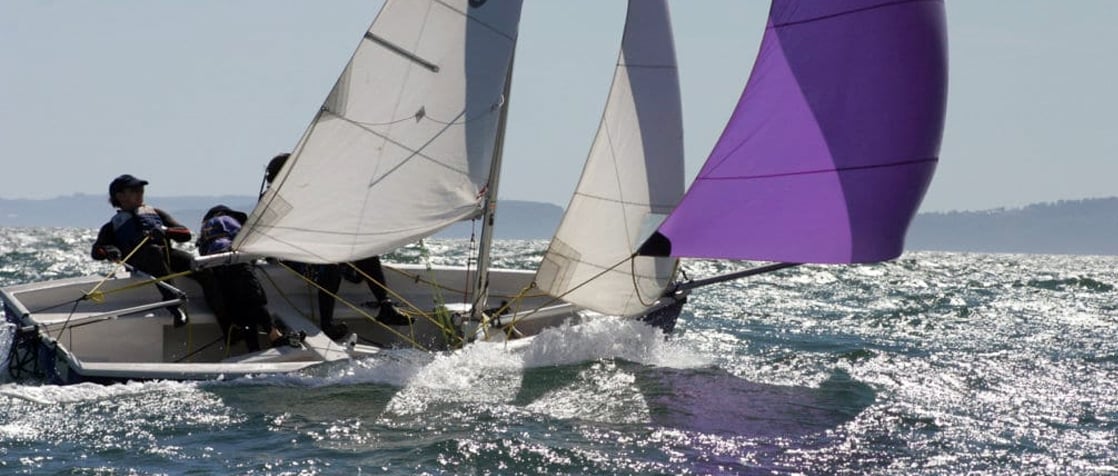
Downwind Sailing - 3 Fundamental Skills
The downwind leg of a sailboat race offers some of the greatest opportunities for overtaking. In downwind sailing, there was once a time when sailors simply let out the sails and took it easy, relying on the wind and waves to propel the boat forward. Olympic legend from Denmark, the four-time gold medallist Paul Elvstrom changed all that when he started really ‘working’ his Finn dinghy down the waves, and starting ‘pumping’ the mainsail. Ever since then, sailors have pushed their boats harder and harder downwind. Here we’ll look at some of the fundamentals of downwind sailing.
Optimal wind flow across the sails in downwind sailing
The great thing about sailing downwind is that even if you do nothing and let the sails flap, the wind will push you further downwind. Unlike sailing into the wind where you really have to know the fundamentals of sailing to get the boat to move upwind, downwind you really don’t have to be that skilled to get the boat moving in the right direction.
Let’s say you’re sailing a basic singlehanded dinghy like an Optimist, Laser, ILCA or something similar. If you point the boat directly downwind and let the sail out to 90 degrees, the boat will move reasonably well through the water because you’ve got maximum projected area catching the wind. You’re treating the sail as a windbreak, the telltales maybe stalled, but you don’t care because you’re sailing the shortest distance from A to B.
In downwind sailing, even on a fairly slow boat like a Laser, it’s always faster to generate airflow across the sail. Keep the boom at 90 degrees, don’t adjust the sheeting. But now luff up or bear away by the lee until you can see the telltales start to stream horizontally across the mainsail. Even though you’re not sailing downwind directly, and potentially travelling a greater distance through the water, the increased efficiency of the sail will more than justify the extra distance with higher boatspeed.
Observe an Olympic fleet of Lasers/ILCAs during downwind sailing, and you'll notice the dramatic steering by sailors, initially sailing by the lee, then slightly headed up, and returning to sailing by the lee again, all while avoiding sailing directly downwind.
Surfing the waves in downwind sailing
Are you sailing faster than or slower than the waves? Laser Olympic Champion from Great Britain, Paul Goodison, says this is a crucial question to ask yourself when sailing downwind.
Slower than the waves?
If the wind is light and you’re going slower than the waves: look behind you and search for the highest bit of the wave to give you a push before it disappears underneath the boat and out in front of you. You’re looking for the biggest push that the wave will give you. Look to either side of you and constantly search for the best wave to give you a helping hand. Luff up or bear away, whatever takes you towards the best part of the wave.
Faster than the waves?
If the wind is stronger, perhaps even strong enough to get your boat up and planing, everything changes. Now, if you’re going faster than the waves, you’re looking for the lowest ‘on ramp’ to the wave in front of you. This time your wave focus is always looking forward and to either side, either luffing or bearing away to find the lowest, easiest part of the wave to catch the waveset in front of you. Once you’ve broken through to the next wave, no time to relax! Now you’re looking for the next on-ramp to the next wave, and so on until the leeward mark.
Aim for the gust
Another factor that you need to keep in mind all the time is where is the strongest wind behind you? If you see more wind coming down one side of the course, steer in that direction to pick up the gust as early as possible. Using a wind sensor can help you identify the direction of the gusts more accurately. Once you’re in the gust, steer to ride the stronger breeze as long as possible, even gybing if you have to.
Sailing with spinnakers and asymmetrics in downwind sailing
So far we’ve been focusing on the dynamics of downwind sailing in slow, conventional boats. Much of the same principles apply to faster boats, but there are some big differences too. Which is why we’ll talk about those in other blog posts.
Downwind sailing: putting it all together
Let’s remind ourselves of the three key factors in downwind sailing we’ve talked about in this post:
- Creating airflow across the sail
- Steering for the best part of the wave
- Aiming for the strongest breeze
Put these three dynamics together and you’ve got the makings of good downwind speed. It can seem like a dark art to begin with. So much of good downwind pace is about ‘feeling’ the boat, ‘feeling’ the waves. That only comes with a lot of practice and time on the water. Once you’ve got that feel, you’ll have a superpower that will supercharge your performance when sailing downwind. It’s one of the best ways to come back from a bad start or first beat. And overtaking multiple boats with superior downwind sailing speed is one of the greatest experiences in sailboat racing.
Watch our webinars
Try out some of the tips and tricks we’ve outlined in this article. Notice what works and what doesn’t. Don’t be afraid to experiment with new ideas in your sailing training. There’s a lot more race-winning info in our series of Webinars.
Join in (for free) with Sailmon’s live webinars where we have some of the very best sailors in the world sharing their go-faster tips with the audience from around the world. Even if you can’t make it to the live session, all the recordings are on Sailmon.com